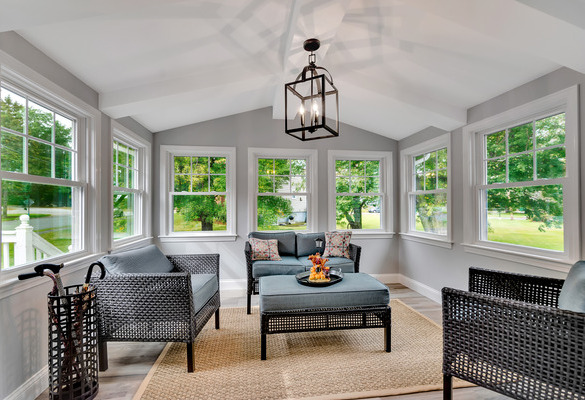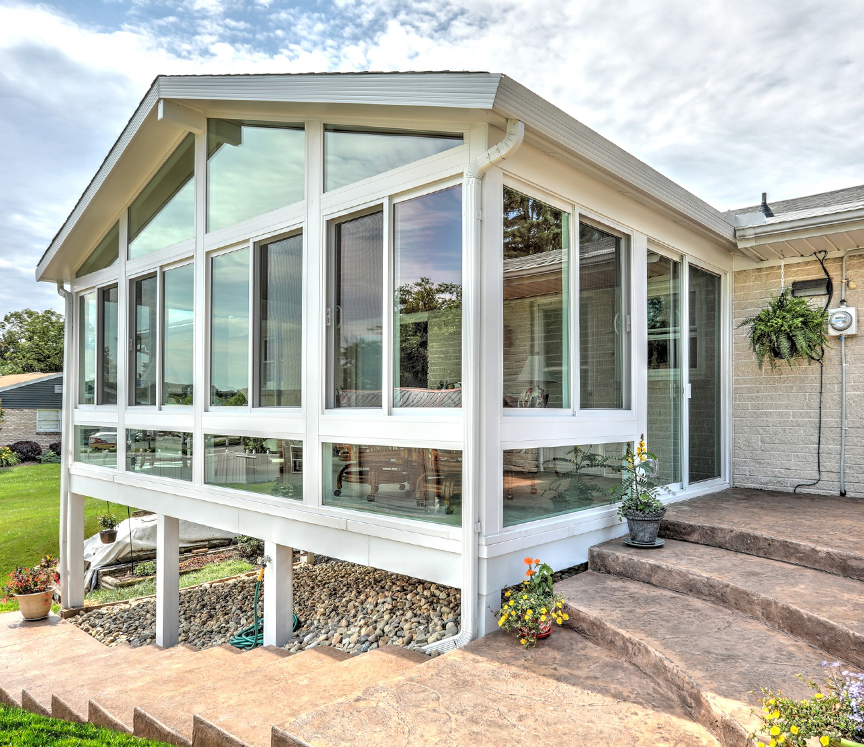
There are multiple benefits to adding a room to your existing home, including the benefit of additional space and the potential to increase your home’s resale value. Sunrooms or solariums are a popular option, especially for those living in pleasant climates, and homeowners can easily customize them to fit their needs and desires. Room additions are just as beneficial, allowing homeowners to increase the square footage of their home and have an additional space in which to spread out, something that’s especially useful for growing families.
While both have their pros, deciding between a sunroom and a full room addition requires some forethought. Mainly, you need to know:
- The difference between a sunroom and a room addition
- The costs associated with building and using a sunroom vs. room addition
- The reason you’re adding in a new room
What Is a Sunroom?
Sunrooms, often known by alternate names, including screen rooms and solariums, are divided up into two types: three-season sunrooms and four-season sunrooms.
As their name suggests, three-season sunrooms are ideal during three out of the four seasons: spring, summer and fall. Three-season sunrooms aren’t insulated, so they cannot provide the comfort needed for winters without an external heating device, such as a portable heater or electric fireplace.
In contrast, four-season rooms provide year-round usability. They’re often insulated, so they can be comfortably used even in the wintertime. Similarly, a solarium is a type of four-season sunroom that has a glass roof.
All sunrooms provide an abundance of natural light, thanks to the glass walls, and ceiling if it’s a solarium, as well as access to the outdoors. Sunrooms can also include additional windows or doors to lead to a yard or patio, or they can be fully enclosed, providing access only from inside the house.
What Is a Room Addition?
A full room addition, also known as a stick-built room, is an added room made from traditional building materials. Unlike sunrooms, which mostly consist of glass panes, a room addition requires a foundation, traditional doors and windows and interior and exterior finishes.
For a room addition, builders pour the foundation and then cover the frame and walls before finishing off the exterior with shingles or siding. The interior of the room requires finishes like built-in electrical access, insulation and paint, with installation or connection to an HVAC system usually also necessary.
Costs of Sunroom vs. Full Room
Cost is often the main obstacle homeowners face when deciding between a sunroom and a full room. Many people ask, “Is a sunroom cheaper than an addition?” and the answer can be both yes or no. The differences in the costs of each type of room depend on several factors, including which type of room it is — a three-season sunroom or a full room addition, for example — and how the homeowner will use it.

 How Much Does It Cost to Add a Sunroom?
How Much Does It Cost to Add a Sunroom?
Sunrooms are available in pre-fabricated kits or can be custom-built to the homeowners’ specifications. Pre-fabricated kits can be more cost-effective than custom-built sunrooms, but that’s not a hard and fast rule. Depending on what sort of customization the homeowners opt for, pre-fabricated sunrooms can end up being more costly than custom-built ones.
While most sunrooms don’t require a foundation, it’s not unheard of for a sunroom to be built with one, which may increase the overall cost for the room as well. And sunrooms also will require a building permit.
Deciding between a three- or four-season sunroom is another consideration that will directly impact the cost. Three-season sunrooms won’t require insulation or additional components, such as connection to an HVAC system, so they may be more affordable. Four-season sunrooms will factor in the cost of insulation, electricity and HVAC connections — and they may also include the price of a foundation if one is necessary.
All types of sunrooms require professional labor and tools, which homeowners should consider in the overall price of the room. But the building part isn’t the only thing that is likely to cost homeowners. Sunrooms, especially four-season ones, are an extension of your home, which means that the household electricity and water bill will likely increase. If the sunroom isn’t as energy-efficient, it will further drive up the household expenses. Add to that the frequency with which the homeowners use the sunroom as well as what they use it for — for example, some may want to make it into a secondary TV room — and the overall cost of a sunroom can be extremely varied.
How Much Does a Full Room Addition Cost?
Full room addition costs are similar to those of a sunroom, with parts and labor as well as a building permit and the frequency of use all factoring into the overall price. The increased materials used will inevitably drive up the cost, and since room additions take more time to build than sunrooms, the labor hours will also increase the price.
Unlike sunrooms, which homeowners have the option of only using for part of the year, a full room addition needs insulation and to be fitted with electrical and HVAC connections so it’s usable all year.
The use of a full room addition may help offset the overall price. If you use it only occasionally, perhaps as a guest bedroom, the infrequent use may help you save money when it comes to household costs. However, a frequently-used entertainment or living room, complete with additional electronics, may increase your household costs.
Uses of Sunroom vs. Full Room Addition
Ideally, it’s a good idea to established the new room’s primary use before deciding whether to opt for a sunroom or full room.
Sunrooms, consisting of glass walls, don’t offer as much privacy, so they’re best reserved for areas that don’t require it. Family rooms, playrooms, second living rooms and hobby rooms are popular options for sunroom uses, allowing a comfortable place with natural light in which to relax.
Full room additions are best if the homeowner intends to use the additional space for something personal, like a bedroom or a home office. While a living room or entertainment room can also be a full room addition, most homes already have one enclosed living or entertainment area, making a sunroom a better — and more unusual — option for communal areas.


Order a Sunroom From Garrety Glass
Whether you’re looking to create a private reading nook, a bright playroom or simply an expanded family room, Garrety Glass has various sunroom options to choose from. With three- and four-season sunrooms to conservatories, we know how a quality sunroom can increase your home’s value in a cost-effective way. Our staff of professionals will work with you to help you pick the best sunroom option for your home and needs, and you can rest assured that you’ll get flexible installation options.
Get in touch to request a free quote by calling 717-741-9949.